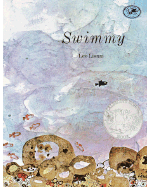 |
Illus. in full color. "A splendid achievement."--(starred) School Library Journal. WINNER 1967 - School Library Journal Best Books of the Year |
|---|---|
 |
Here is a Leo Lionni book for the very youngest! “ What shall we do today?” two mice ask each other. |
 |
Illus. in color. WINNER 1963 - ALA Notable Children's Books |
 |
The wordbug teaches the letters on the alphabet tree, torn and tossed by a windstorm, how to become stronger by banding together to form words. Then a clever purple caterpillar teaches the letters to become even stronger by forming sentences with a message of peace. Available in hardcover for the first time in many years, The Alphabet Tree is Leo Lionni’s gentle parable about the power of the written word in a democratic society. |
 |
“Let’s make rabbits,” says the scissors to the pencil, But one day the rabbits find a real carrot. “Let’s eat it,” the hungry rabbits say. A taste of the real carrot leads to a wonderful surprise ending that is sure to delight very young children. |
 |
Caldecott Medalist Leo Lionni's classic tale about three childlike frogs who learn a valuable lesson about cooperation is now available in paperback. "This story of selfishness on the pond, carried out in beautifully simple collages and language, is a fine choice for story hours."--School Library Journal. |
 |
reviewed by Carol Otis Hurst Leo Lionni devised this story while on a train trip with his grandchildren. Usually he drew stories for them as he told the stories but this time he had no drawing materials. Tearing circles of color from a magazine, he improvised this story and later wrote it down for the rest of us. Illustrated with splotches of color, the story has several layers of meaning from the simple story of friendship through the exploration of color to the feelings of racial prejudice. We are shown Little Blue as a ragged circle of blue on the white page. Later we meet his mother and father, his many friends, but especially Little Yellow who lives across the street with Mama Yellow and Papa Yellow. Using only these simple shapes, Lionni shows the children at school and at play. Then, when Little Blue and Little Yellow are separated for a bit only to find each other at last, they are so joyful that they hug each other and turn green. As a single green shape, they play and then go, first to Little Blue's house and then to Little Yellow's only to be rejected and unrecognized. They cry little blue and yellow tears until they are all tears and then, punningly, they "pull themselves together and go home" as separate shapes again. |